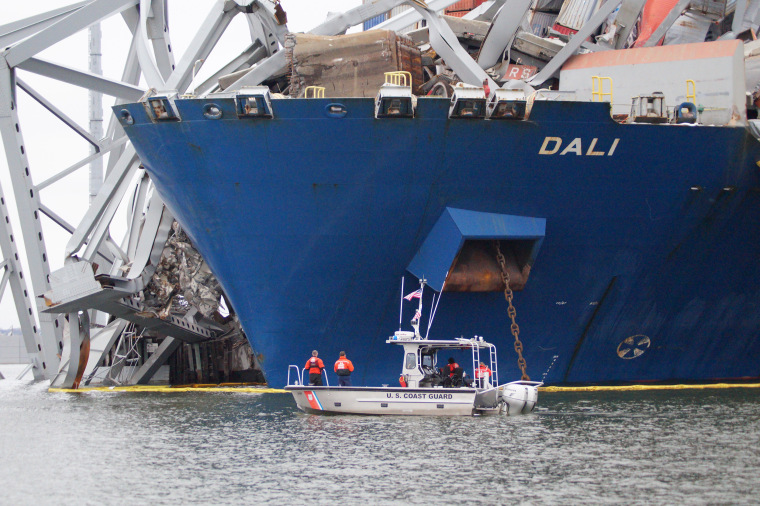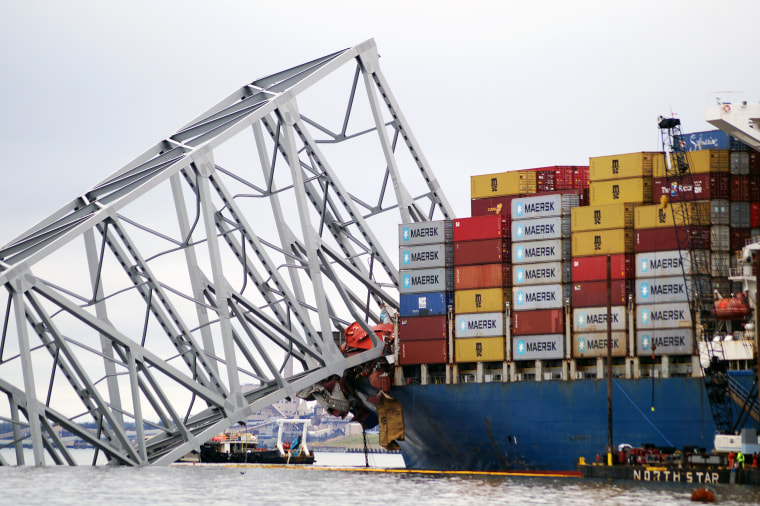Crews in Baltimore are preparing to use precision explosive charges to free the Dali container ship from underneath wreckage of the Francis Scott Key Bridge.
Salvage crews will detonate explosive charges to separate the bridge truss pieces strewn across the bow's containers from the ship, Unified Command Petty Officer Ronald Hodges said.
Officials have deemed it safe for the ship's crew to remain on board and shelter in place while the explosives are detonated.
“The unified command made that choice with their safety being their No. 1 priority,” Hodges said.
Two driving factors led officials to that method of separating the bridge wreckage from the Dali: crew safety and speed.

“It’s the safest means for the crew members who are actually working on removing that span," Hodges said. "On top of the fact that it's a lot faster of a method."
For weeks since the deadly bridge collapse on March 26, crew members working atop cranes have been painstakingly cutting into steel pieces to prepare sections for removal. Using explosives should help accelerate the salvage process and minimize risk to the crane operators working under tough conditions.
A spokesperson for the ship’s owners said that authorities have communicated their plan and that company representatives remain on site.
“Safety is everyone’s top priority,” spokesman Darrell Wilson said, adding he trusts the experts’ assessment and plan. “Within the salvage community, some of the best experts in that field are in Baltimore working on this response."
Salvage teams Tuesday found remains of construction worker José Mynor López, the final missing victim of the collapse.
“With heavy hearts, today marks a significant milestone in our recovery efforts and providing closure to the loved ones of the six workers who lost their lives in this tragic event,” said Col. Roland L. Butler, Jr., superintendent of the Maryland State Police.
Baltimore Mayor Brandon M. Scott acknowledged the grief six families had experienced.
“Since the beginning, we’ve made clear to these families that they do not bear the burden of their grief alone," Scott said in a statement. "We will forever be with them, ready to aid and support them in whatever way is needed. As we close this chapter in this effort and continue the work of fully reopening the channel — we will never forget to center the loss that we felt as a result of this unthinkable tragedy and the lives that were forever changed as a result.”
The precision explosive method of extricating the ship from the wreckage is planned to be a “multiday process” with a fluid timeline dependent on cooperative weather.
The Port of Baltimore announced last week that the 45-foot Fort McHenry limited access channel would be reopened "on or about May 10 following the expected removal of the Dali vessel."
Officials are doing everything they can to prevent further damage, Hodges said.
Hodges noted the process is similar to the one used in demolishing the Gov. Harry W. Nice Bridge last year.
Officials recently estimated it could take until 2028 to rebuild the Key Bridge. The Army Corps of Engineers has maintained its goal of reopening the Port of Baltimore's permanent 700-foot wide, 50-foot-deep channel by the end of May.
